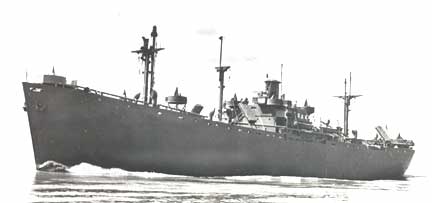MCQUALITY-GERALD
GERALD E. MCQUALITY

UTILITY SEAMAN

ONE OF THE MOST REMARKABLE SURFACE BATTLES OF WWII
Historical records are scarce concerning Gerald E. McQuality but do report that he was a survivor of one of the most remarkable surface battles of World War II. Available records show his hometown was Macon, Illinois, and he was a Utility Seaman crewmember of the SS STEPHEN HOPKINS.
The SS STEPHEN HOPKINS, a Liberty Ship of the U.S. Merchant Marine, was launched in May 1942. Her maiden voyage took her from San Francisco to Bora Bora, New Zealand, Australia, South Africa and then into the Atlantic Ocean bound for British Guiana, where on the morning of September 27, 1942, she met her fate off Surinam. While proceeding through haze she spotted two ships coming out of the fog not far away. The ships were the German surface raider STIER and its supply ship TANNENFELS. The STIER was a former merchant ship disguised as a neutral-flag cargo ship, but her profile had been changed with the addition of fake masts and stacks, and she now carried six 5.9-inch guns hidden behind false deck panels.
A scant three minutes after the two ships were sighted and they neared to about 1,000-yards, shots suddenly pierced the STEPHEN HOPKINS superstructure. As Navy Armed Guard gunners and mariners assigned as loaders raced to their guns, they saw a ship off the starboard bow about their same size firing at them. Thus, began one of the most remarkable surface battles of World War II. Explosions rocked the ship and machine gun fire was raking the decks. One of the first shells killed two mariners as they stepped on deck. The order was given to steer STEPHEN HOPKINS so the stern with its single World War One era 4-inch gun would point at the enemy and at the same time present the smallest target. Although severely wounded by shrapnel, the commander of the Armed Guard expertly directed the 4-inch gun at the waterline of the German raider, getting a shot off about every 45-seconds. They made every shot count as they hit the STIER’s rudder and then damaged its forward guns.
STEPHEN HOPKINS took damaging shots as one pierced the hull hitting directly into the engine room as the ship went almost dead in the water. The STIER continued putting shell after shell into the upper works of STEPHEN HOPKINS. A large caliber shell hit near the 4-inch stern gun killing all the men nearby. A Merchant Marine cadet saw the 4-inch gun was deserted, so although untrained, he manned the gun alone and fired all five shells left in the ready box, scoring hits with all five. Very shortly thereafter the cadet was killed by a shell which exploded nearby. The firefight lasted about half an hour and a total of 35 shells hit STIER, leaving her in shambles as was the STEPHEN HOPKINS. Both ships were on fire and sinking. After an hour or so she sank as did the STIER.
As the battle concluded, surviving crewmembers lowered the only seaworthy lifeboat into the water and soon nineteen survivors from the sixty men who had been aboard managed to board the lifeboat. The sole surviving officer took command of the lifeboat which had no navigational instruments other than a compass. With little food and water, a course was set for land 2,200 miles away. The small boat beat her way westward for thirty-one days. Many times heavy weather was encountered, forcing the survivors to put out a sea anchor and heave-to because of high seas. In spite of all efforts in their behalf, three wounded crewmembers died and there were times when delirium threatened. Finally, sixteen desperate men made a safe landing at a remote fishing village in Brazil. A U.S. Navy lieutenant sent to meet them commented that they “were never for one moment beaten. After days of being battered together on a cramped lifeboat, they were still lavishing praise on one another, helping one another.”
When news of the battle was released the STEPHEN HOPKINS was hailed as a “Hero Ship” and the ship and its crew were awarded the U.S. Maritime Commission’s Gallant Ship Unit Citation. During World War II it was the only U.S. merchant ship to sink a German surface warship.
Historical records reveal that Gerald E. McQuality apparently married and returned to Illinois after his epic journey to Brazil. He reportedly died at the age of 50 in Winnebago County, Illinois, on August 29, 1971 and has been buried with family members at Darien Cemetery in Darien, Wisconsin.
Submitted by CDR Roy A. Mosteller, USNR (Ret)

